3D printing with PLA vs. PETG: What's the difference?
Learn the benefits of PLA and PETG, when you should use one instead of the other, post-processing techniques that work for both materials, and more.
Read articleYou’ve come to the right place. Hubs is now Protolabs Network.
The same broad capabilities, exceptional quality and competitive pricing under a new brand.






EN
Polylactic acid, also known as PLA, is a thermoplastic material commonly used in additive manufacturing. It is one of the most commonly used materials in 3D printing, and can be used to create a wide range of parts, packaging, and prototypes for the medical, food, cosmetics, and textile industries, among others.

Here, we’ll look at how PLA is made, as well as its origins, uses in manufacturing and 3D printing, and more.
PLA is made by fermenting the sugars in plant-derived materials such as corn starch or sugar cane to produce lactic acid, which is then condensed into a lactide and polymerized. From there, PLA can be sold as raw granulated plastic for use in manufacturing processes such as injection molding and casting. Alternatively, PLA can be turned into a filament, spooled, and sold for use in additive manufacturing.
PLA was created in the 1930s, but did not begin to be widely used until the 1980s. Its use in 3D printing grew in popularity after that time, thanks to PLA’s ease of use and relatively low cost.
PLA is used in a great number of industries for a wide variety of applications. Among them:
Food & beverage. Because it is derived from natural sources, PLA is non-toxic and food-safe. It can be used to package items that will be consumed by humans.
Medical. PLA’s non-toxicity means it can be used to create parts or components such as binding screws or other implantable devices.
Textiles. PLA is breathable and light, making it an excellent choice for creating textiles.
Cosmetics. PLA is relatively affordable and eco-friendly, and is an increasingly popular choice for the creation of cosmetics packaging – both from a cost and environmental standpoint.
Prototyping. Especially when 3D printed, PLA is a solid candidate for prototyping, where speed, cost, and ease of use are of utmost importance.
In this section, we’ll take a look at various types of PLA, typical pricing, and material properties.
There are three main types of PLA – PDLA, PLLA, and PDLLA. Get to know the properties of each.
PDLA (Poly-D-Lactic Acid). PDLA biodegrades more slowly than other types of PLA.
PLLA (Poly-L-Lactic Acid). PLLA is most commonly used in 3D printing and injection molding. PLA+, a type of 3D printing material that is stronger than regular PLA, is also typically made with PLLA, albeit with strength-increasing additives.
PDLA (Poly-D-Lactic Acid). PDLA breaks down more quickly than other types of PLA, making it a good choice for pharmaceutical applications that will be ingested by humans or animals.
Additionally, PLA is available in many colors and finishes, such as matte, glossy, and silk. It can also be purchased in hybrid form – containing a mix of PLA and materials such as wood, or with additives that increase properties such as strength or flexibility.
Prices of PLA 3D printing filament will vary, depending on factors including color and characteristics. For example, hybrid filaments that combine the properties of PLA and materials such as wood – or increase properties such as strength or flexibility – will be more expensive than regular PLA filament. Typically, however, prices of PLA 3D printing filament will fall between €20-70 per kilogram.
PLA is derived from natural materials, which means it is much more environmentally friendly than other plastics. It is biodegradable, compostable, and recyclable.
PLA has several interesting properties. Among them:
High stiffness. PLA is a very stiff and brittle material, which means it also features low flexibility.
Good strength. PLA is a relatively strong material, featuring a flexural strength of 103 MPa.
Low melting point. A melting point of approximately 145 °C makes PLA well-suited for 3D printing.
Good aesthetic properties. Because of its low melting point, PLA material can be used to create parts that exhibit smooth surfaces and fine details.
Low UV and temperature resistance. PLA will quickly deform under high temperatures and UV light.
Chemical resistance. PLA is chemical-resistant and is not soluble in solvents such as acetone or isopropyl alcohol, although certain chemicals can cause it to release lactic acid, which can be harmful in large quantities.
Dimensional stability. PLA is not prone to warping, meaning it can be used to print large parts that are very close to a 3D model’s dimensions.
In this section, we’ll take a look at best practices to consider when 3D printing with PLA, as well as several popular post-processing techniques for the material.
Consider these things when designing or creating parts with PLA 3D printing filament so that you can print more effectively and efficiently.
Oozing. Because of its low melting point, PLA is prone to leaking from the nozzle of the 3D printer. The printer’s retraction settings can be adjusted to prevent this.
Cooling. PLA filament stays soft for quite a long time, meaning effective cooling is a must. The 3D printer’s fan should stay on full power during the entire 3D printing process to be sure that layers effectively cool.
Consider a heated print bed. PLA does not require a heated print bed, but using one can increase or decrease the material’s adhesion – depending on the bed’s temperature and what is required for the part you are creating.
Find the right nozzle temperature. To prevent stringing and other undesirable aesthetic qualities, the 3D printer’s nozzle should be fine-tuned to the type of PLA being used – typically between 190-230 °C.
The following are a few ways that PLA 3D printing filament can be post-processed.
Support removal. PLA 3D printing filament is often printed using PVA (polyvinyl alcohol) as a support material for overhangs or other tricky areas. When creating a part using PLA and PVA, the finished part is submerged in water to dissolve the support material (as PVA is a water-soluble polymer).
Sanding. PLA is capable of achieving smooth surfaces, but certain areas may need to be sanded to make them smoother.
Polishing. Parts created with PLA can also be polished using a buffer to create the smoothest possible surfaces.
Painting. PLA filament is available in a wide variety of colors, but you may nevertheless want or need to paint PLA-printed parts, depending on the application.
Want to learn more about 3D printing? Read our full guide: What is 3D printing? Or check out our article,How to design parts for FDM 3D printing.
When you’re ready to start 3D printing, upload a CAD file for an instant quote and automatic DFM analysis. You can also ask any questions about the process or request something specific by contacting networksales@protolabs.com.

PLA stands for polylactic acid.
PLA is technically biodegradable, but only under demanding composting conditions, making it one of the most sustainable 3D printing materials.
PLA is a plastic known as a thermoplastic, which means it becomes liquid at its melting point.
Although PLA is stronger and stiffer than ABS, it is also brittle and less heat-resistant – meaning ABS is better for industrial applications.
FDM 3D printing sees PLA filament melted and applied layer by layer to form a final tool or part.
Protolabs Network offers PLA 3D printing filament in many colors (black, white, red, green, blue and gray). You can inquire about finishes such as matte, glossy and silk via our sales team.
PLA is easy to print, comparatively inexpensive and eco-friendly, non-toxic, and available in many colors and finishes.
PLA is brittle and features low temperature and UV resistance, which means it is not well-suited to industrial or outdoor applications.
The food and beverage, medical, and textile industries are all major users of PLA material.
PLA material is relatively affordable. If you’re looking to save money on PLA, look for non-hybrid forms of the material.

Learn the benefits of PLA and PETG, when you should use one instead of the other, post-processing techniques that work for both materials, and more.
Read article
Learn the benefits of PLA and PLA+, when you should use one instead of the other, post-processing techniques that work for both materials, and more
Read article
Nylon, also known as polyamide (PA) is a synthetic polymer with high tensile strength, excellent resistance to wear and abrasion, and a low coefficient of friction. Here’s how it’s used in manufacturing and engineering applications.
Read article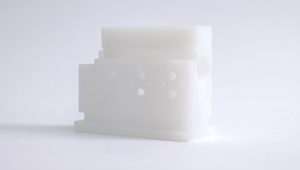
Want to learn more about chemically resistant parts? Find out about common chemical-resistant materials, their advantages, disadvantages, and industrial applications.
Read article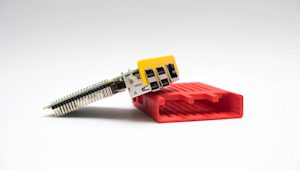
Polylactic acid, also known as PLA, is a thermoplastic material commonly used in additive manufacturing. It is one of the most commonly used materials in 3D printing, and can be used to create a wide range of parts, packaging, and prototypes for the medical, food, cosmetics, and textile industries, among others.
Read article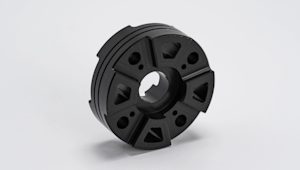
What is Delrin and why is it unique among the many manufacturing materials available? Delrin, or POM-H (homopolymer acetal), is used in CNC machining, 3D printing and injection molding to create durable, precise components. This article explores Delrin’s properties and how to get the most out of the material.
Read article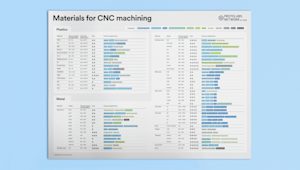
What’s the best material for machining your parts? Check out this side-by-side comparison of the strength, price and application for CNC plastics and metals (in a handy, printable poster).
Read article
This comprehensive guide compares the 25 most common materials used in CNC machining and helps you choose the right one for your application.
Read article
What are the different materials available for SLA 3D printing? This article compares the main printing resins, including standard, tough, durable, heat resistant, rubber-like, dental and castable, by material properties. Find the best material option for your application.
Read article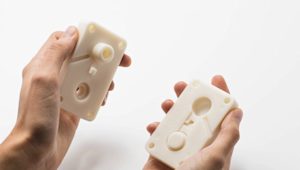
We compare critically two industrial 3D printing materials used for low-run injection mold manufacturing.
Read article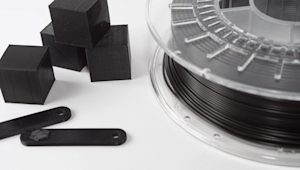
What’s the ideal material to use when 3D printing parts with FDM? This article compares the most common FDM 3D printing filaments, including PLA, ABS, PET, Nylon, TPU (Flexible) and PC, by their material properties to help you find the best option for your application.
Read article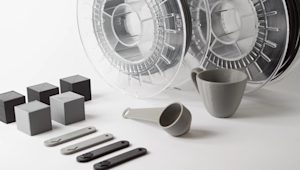
PLA and ABS are two essential materials for 3D printing with FDM. They are also two of the most popular materials on our platform. This comparison will help you choose which material to use for your 3D-printed custom parts.
Read article
Learn the benefits of PLA and PETG, when you should use one instead of the other, post-processing techniques that work for both materials, and more.
Read article
Learn the benefits of PLA and PLA+, when you should use one instead of the other, post-processing techniques that work for both materials, and more
Read article
Nylon, also known as polyamide (PA) is a synthetic polymer with high tensile strength, excellent resistance to wear and abrasion, and a low coefficient of friction. Here’s how it’s used in manufacturing and engineering applications.
Read article
Want to learn more about chemically resistant parts? Find out about common chemical-resistant materials, their advantages, disadvantages, and industrial applications.
Read article
Polylactic acid, also known as PLA, is a thermoplastic material commonly used in additive manufacturing. It is one of the most commonly used materials in 3D printing, and can be used to create a wide range of parts, packaging, and prototypes for the medical, food, cosmetics, and textile industries, among others.
Read article
What is Delrin and why is it unique among the many manufacturing materials available? Delrin, or POM-H (homopolymer acetal), is used in CNC machining, 3D printing and injection molding to create durable, precise components. This article explores Delrin’s properties and how to get the most out of the material.
Read article
What’s the best material for machining your parts? Check out this side-by-side comparison of the strength, price and application for CNC plastics and metals (in a handy, printable poster).
Read article
This comprehensive guide compares the 25 most common materials used in CNC machining and helps you choose the right one for your application.
Read article
What are the different materials available for SLA 3D printing? This article compares the main printing resins, including standard, tough, durable, heat resistant, rubber-like, dental and castable, by material properties. Find the best material option for your application.
Read article
We compare critically two industrial 3D printing materials used for low-run injection mold manufacturing.
Read article
What’s the ideal material to use when 3D printing parts with FDM? This article compares the most common FDM 3D printing filaments, including PLA, ABS, PET, Nylon, TPU (Flexible) and PC, by their material properties to help you find the best option for your application.
Read article
PLA and ABS are two essential materials for 3D printing with FDM. They are also two of the most popular materials on our platform. This comparison will help you choose which material to use for your 3D-printed custom parts.
Read articleShow more
Show less